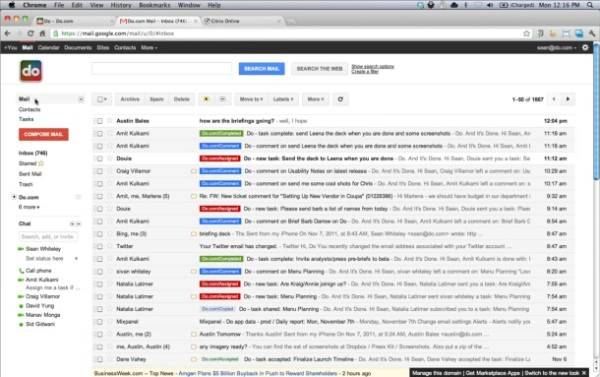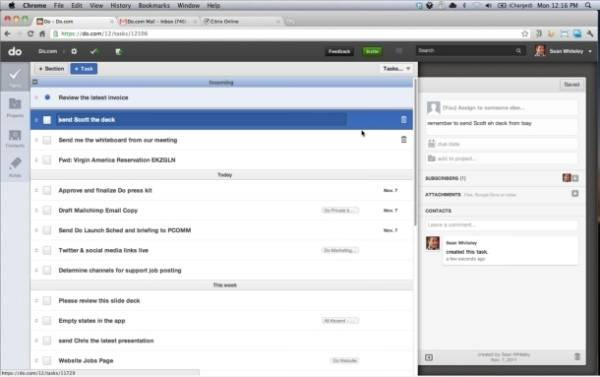In a very short period of time – just the last 18 months – Salesforce.com has risen from “up-and-comer,” straight through “challenger” status, to the potential out-and-out leader in workforce software. Every move it has made so far, including the December 2010 purchase of open cloud platform Heroku, has been part of a well-played strategy thus far to build leveraged platforms in cloud-based services the way Microsoft leveraged its platforms for office applications… only somewhat faster.

This morning, Salesforce has fired a volley straight at the heart of Microsoft’s leveraged tower. Do.com – a free, Heroku-based service coupled with Gmail, but enabled for all e-mail users – is a cloud-based, socially-oriented task management and collaboration platform aimed not just at Salesforce’s typical office user, but the general public. It serves not only as a group planning tool for any scale of project, including the smallest scale (e.g., remembering to pick up groceries), but as a kind of cloud desktop for collaborating around Google Docs.

“Do.com is for anyone and everyone,” says Sean Whiteley, Salesforce’s Senior Vice President, in an interview with RWW. “We’re calling this a prosumer application. It’s the closest thing to a consumer app we’ve ever done.”

The basic idea of Do.com is that Gmail users will be able to visualize their contacts better, and organize their communications with those contacts around tasks and projects. But the task concept is loose enough to apply to just about any type of association; it could literally be a group of neighbors gathering together to fix someone’s fence, or launch a political campaign for a local city councilperson, or start a barbecue or a blog. One example contacts list appears below.

“A lot of people have referred to [Do.com] as a social productivity app,” Whiteley goes on, “but really it’s the set of things that you need to manage task lists – it can be your own task lists, or ones you share with a group of others. You can organize small or big projects, at home or with life or at work. Plus there’s some utilities such as easily taking notes and having them on all your devices – the basic sets of things you need to get work done with other people.”
The contacts lists Do.com users will put together do not have to be just co-workers or just family members. In other words, this is not an extension of a Salesforce or a Chatter app, but rather a rewrite of the very popular collaboration app Manymoon that Salesforce acquired outright last February.

“You can use it to collaborate with customers, partners, prospects, clients, or your friends and family. You can use it to get things done with anybody,” the SVP tells us. “We do have a Gmail gadget, or you can also pop right into Gmail and use it to create projects or assign tasks right from Gmail without even leaving your e-mail.”
The system is structured to enable users to bring contacts into tasks without them having to be Do.com users first. From the task organizer’s viewpoint, her contacts may already be assigned; meanwhile, the contacts themselves are receiving invitations to join Do.com. Clicking on “Join” and entering a new username and password enrolls the new user, who will instantly see the tasks assigned to him. “You can work with anybody on anything,” says Salesforce’s Whiteley, “and all you have to do is invite them to use a project or assign them a task. Then as a member of this workspace, they can collaborate with the people to complete the projects and tasks.

The SVP also told us a real-time activity feed with personal alerts, and a dedicated real-time IM mechanism (shown above on the right panel) are included with Do.com – a significant expansion of Salesforce Chatter.
Salesforce is beginning its first limited public beta testing today, with plans to expand testing in the coming months. It’s an HTML5 version of Manymoon that was rebuilt using Ruby on Rails and Heroku services. For now, Do.com is accessible as a Web app through all browsers at the (obvious) home address, and through an iOS mobile app for iPhone and iPad. An Android-based mobile app is forthcoming.

Although Do.com will be coupled with Gmail, through a clever method, it will actually be accessible through any e-mail client, including Outlook, without the use of extensions. “You can assign tasks very simply by sending an e-mail to [email protected], and we’ll automatically resolve where that e-mail came from, and we’ll create a task for you based on that e-mail. Or you can do the same thing with a note; if you wanted to take a note in your e-mail, you could send it to [email protected], and we’ll automatically create a note for you.”
Do.com will also send notifications through e-mail, or through the iOS native app, for task-related events. Any replies made to those notifications will be automatically added by the Do.com server as threads in the ongoing conversation for the project.

Single sign-on capability will be offered for users with Salesforce, OAuth, Facebook, and Google profiles – this way, you’re not logging on multiple times. However, the Do.com platform is not, Whiteley informs us, an extension of Salesforce’s Data.com platform. That’s important, because it means Salesforce is not (for now) mining the data it gleans from Do.com users for use by Salesforce.com apps.
Salesforce has plans to expand the Do.com ecosystem (did you think it wouldn’t?). A paid, premium version of the app, with added features to be determined, will be made available next year. No word yet as to whether this will be on a subscription model or a one-time fee. Furthermore, Salesforce is opening up the API for Do.com to enable developers to build apps around it. The company’s AppExchange market, which is currently based around Salesforce and Force.com apps, will be expanded to feature Do.com apps as well, the company tells us.
Do.com is not a substitute for Outlook. But that may not matter, as it may provide the “killer app” functionality that Outlook has been lacking for many users, in the form of a truckload of users gift-wrapped especially for Gmail. As Salesforce improves Do.com’s tie-ins with Google Apps, the foundation of Microsoft Office’s stronghold on home offices and small businesses will come under possibly the first serious competitive challenge in over a decade. What binds users to Office is their reliance upon Outlook to share attachments made with Word, Excel, and PowerPoint. And what binds offices to Exchange Server is their users’ reliance upon Outlook. If users can see what they’re working on, plan each other’s projects, and keep track of progress without relying upon a service supplied by Exchange or SharePoint, then Do.com becomes a genuine threat to Office applications and to Office 365.
Salesforce has authorized ReadWriteWeb to offer free beta test passes to the first 200 readers who respond now. SIGN UP NOW BY CLICKING HERE.

















